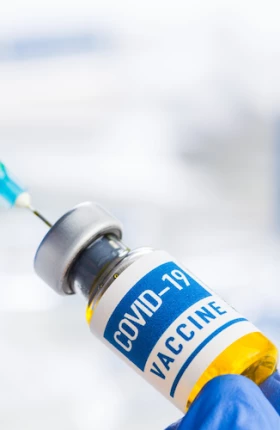The COVID-19 pandemic taught governments and health institutions around the world some critical lessons. From gaps in disease monitoring and surveillance to the slow rollout of countermeasures such as diagnostics, vaccines, and therapeutics, the crisis exposed pandemic preparedness and response (PPR) challenges and inadequacies in global health care. Although governments and health organizations have made significant progress and developed robust infrastructure, we are at risk of losing some of these gains as the pandemic fades from public consciousness and attention wanes—leaving countries vulnerable to future outbreaks.
Consider the spread of mpox (previously known as monkeypox), which arrived just as the COVID-19 pandemic had begun to subside. Rather than being seamlessly activated, the initial responses of many countries were reminiscent of missteps in the recent past. The mpox crisis is a reminder of how critical it is for government agencies, NGOs, foundations, and other health entities to act on lessons learned from previous outbreaks. This will ensure that PPR structures, processes, and systems remain accessible and ready, allowing countries to rapidly respond to and contain emerging diseases.
Over the past three years, many public-health bodies—including the Independent Panel for Pandemic Preparedness and Response, appointed by the director general of the World Health Organization (WHO)—have made recommendations intended to strengthen and enhance PPR capabilities. This article, based on conversations with public-health leaders and incorporating the lessons learned from COVID-19 and mpox, distills those varying recommendations down to four practical, actionable steps for governments and health institutions.
1. Strengthen the Focus on Health Equity
Health equity is generally discussed in terms of national differences: people in low- and middle-income countries often don’t have access to the medical care and resources that are available to people in higher-income countries. But there can also be inequities within a single country, with some people enjoying better access to care and better health outcomes than others. This is true even in higher-income countries with robust national health care systems.
One year into the COVID-19 crisis, for example, the death rates among ethnic minorities in England were two to four times higher than among the white population. In the US, disparities in vaccination rates were stark. By July 2022, only 59% of African-American and Black people had received at least one COVID-19 vaccine dose, compared with 87% of Asian people and 64% of white people. One reason was that public-health recommendations were initially focused on overcoming vaccine hesitancy among African Americans, rather than ensuring that the majority of those who wanted to be vaccinated could do so. Another reason was that vaccines were initially funneled through established health systems—thus exacerbating existing disparities in care.
The disparities with mpox were also striking from the outset. As of July 2022, more than 95% of cases in the US were among men or transgender women who had recently had close intimate contact with other men. Within this group, Hispanic and Black people made up a disproportionately large number: roughly 55% of all cases. Contributing factors included limited information about precautionary measures, vaccine qualification criteria that likely made some patients uncomfortable (such as requiring that they report their number of sexual partners over a specific period), and an insufficient number of vaccine doses distributed at only a few, often inconvenient, locations such as major hospitals, leading to long lines and requiring patients to take time off from work.
The mpox crisis is a reminder of how critical it is for government agencies, NGOs, foundations, and other health entities to act on lessons learned from previous outbreaks.
To maintain a strong focus on health equity in PPR, governments and other health organizations should take the following measures:
- Ensure that communications and countermeasures are tailored to those who are underserved by traditional care pathways and are most vulnerable or at risk. Rollout of vaccination campaigns should be designed to engage the relevant communities; mpox vaccines, for instance, could be distributed at gay pride events and in other nonclinical settings.
- Ensure that media coverage and public communications avoid creating or reinforcing stigmas that could deter people from receiving care. Engage community leaders in delivering messages and making information clear and accessible. Although the early response to mpox in many countries was flawed, much of the subsequent success in curbing the disease has resulted from organizing within the LGBTQ community and applying lessons from the AIDS epidemic to the sharing of information about testing, vaccines, and behavioral changes.
- Maximize patient and community involvement in PPR systems—through representation, consultation, and leadership—to assess the impact of policies and communications.
- Incorporate equity in access and outcomes as core components of data and monitoring frameworks.
- Consider including a chief equity officer on local, regional, or national PPR teams and task forces to ensure that communities are being fairly and equitably served.
2. Develop More Nuanced Emergency Alerts
Once a disease reaches a certain threshold, the WHO can—based on the advice of experts—declare a public-health emergency of international concern (PHEIC). The designation has wide-ranging consequences, unlocking financial resources and creating a legal obligation for governments to respond. Many countries link their emergency health declarations to those of the WHO.
Subscribe to our Social Impact E-Alert.
That process oversimplifies the spread of disease, however. WHO authorities rightly want to avoid making a decision too early, to avoid stoking panic. But in the absence of the emergency designation, many people—and even governments—may downplay concerns and lose critical time at the early stages of an outbreak, when the spread of a pathogen is easier to control. A more nuanced system would allow countries to differentiate outbreaks by their potential severity and intervene at the right time with the right level of countermeasures. For example, the point when the WHO starts its assessment could signal the first level of alert, when countries would initiate early responses and ensure preparedness.
In addition, governments and health institutions should make the emergency declarations themselves more nuanced, with different starting points triggering different responses. For instance, governments and health institutions could develop universal levels of emergency, similar to the DEFCON warning system used by the US military; each level would call for the mobilization of specific resources, so governments could launch containment measures early on, when they are more likely to be effective.
A more nuanced warning system would allow countries to differentiate outbreaks by their potential severity and intervene at the right time with the right level of countermeasures.
3. Ensure Flexibility of Digital Platforms
In responding to COVID-19, many governments at the local, state, and national levels built digital platforms that people could use to schedule tests and vaccines, verify their vaccination status, and trace close contacts. In some cases, the services were deployed on existing infrastructure to great effect. For example, India quickly leveraged its digital public-health tools to produce a secure and user-friendly platform that coordinated logistics, administrators, patients, and technical support. But in many cases, infrastructure built specifically for COVID-19 is not capable of supporting responses to future pandemics. Some digital platforms put in place to manage COVID could not be used for mpox, for example, and people at risk had to resort to waiting in line at clinics and hospitals and tracking their vaccine status on paper cards.
Digital platforms are a critical part of governments’ PPR infrastructure, providing centralized information about testing, vaccines, and other services. To ensure that they are sufficiently flexible to be used repeatedly over time, governments should take the following steps:
- Evaluate platforms built for COVID-19 and ensure that they can be adapted to respond to the next unknown pathogen anywhere in the world.
- Consider best practices from other countries—coordinated at the international level—and ensure that successful response platforms can be replicated and scaled. Some governments have developed open-source systems and allow other countries to adapt them for their own use. For example, France’s app for making COVID vaccine appointments can be used by other governments for different diseases.
- Build digital systems that can coordinate response mechanisms and monitor the spread of endemic diseases—including global health priorities such as polio and malaria.
- Invest to improve and maintain digital platforms over time, particularly in between large outbreaks or pandemics.
4. Build Private-Sector Partnerships that Can Scale Up in an Emergency
Collaboration with the private sector can dramatically increase the capacity of PPR infrastructure. For example, in the case of both COVID-19 and mpox, many governments initially relied exclusively on government-affiliated labs to conduct testing—an approach that severely restricted capacity. Early in the mpox outbreak, the US could process only about 6,000 test samples a week, far below what was needed. Eventually, the government contracted with five commercial labs, increasing capacity to 80,000 samples per week. In contrast, South Korea, from the outset, conducted large-scale testing for COVID-19 through both national and commercial labs, enabling the government to identify infected individuals and halt the spread of the disease in the early stages.
The value of partnerships applies as well to supply chains that support vaccine production and distribution. Although many countries now have sufficient doses of the mpox vaccine, the global supply initially came from a single private-sector provider, resulting in significant shortages. Governments worked to establish private-sector partnerships and scale up production capacity quickly. Meanwhile, effective community action curtailed the spread of the virus.
Collaboration with the private sector can dramatically increase the capacity of PPR infrastructure.
At the global level, vaccine supplies can be affected by border closures and other responses to crisis. For example, high-income countries initially stockpiled vaccine doses that vastly exceeded their need in 2021, while many countries experienced export controls for critical countermeasure components and products. Yet the international COVAX partnership (directed by Gavi, the Coalition for Epidemic Preparedness Innovations, and the WHO, and supported by UNICEF) was successful in part because it was able to accelerate the response of public- and private-sector partners.
Public-health institutions at the global and national level (and at the state and local levels, where applicable) can apply these lessons to their PPR strategies by taking the following steps:
- Establish a network of trusted private-sector providers and secure advance commitments to scale response efforts—including testing, contact tracing, and manufacturing (of personal protective equipment, vaccines, and oxygen, for example)—at the earliest stages of an outbreak.
- Develop contracts with the private sector to provide services and supplies in nonpandemic situations, with contract structures that can be easily modified as needed to contain future outbreaks.
- Provide public- and private-sector seed funding at the national and international levels. Additionally, ensure that funding creates the right incentives to expand testing capacity and tracking in order to monitor outbreaks and rapidly institute countermeasures.
- Develop logistics infrastructure that will be more resilient to global supply chain disruptions—for example, national cold chain solutions for the manufacture, storage, and distribution of vaccines. Innovative financing mechanisms may be needed to give the private sector incentives to invest in flexible capacity.
The mpox outbreak should have been contained more quickly and effectively, arriving as it did on the heels of COVID-19. Yet governments and health institutions were often slow to react, and some of the infrastructure and processes required had to be created again from scratch. Now, as the focus on COVID-19 and mpox fades, governments and health institutions must avoid making that mistake again. The window of opportunity is small. If countries are to fight future pandemics effectively—and save lives—they must learn from the lessons of both pandemics and take decisive, informed action now.











